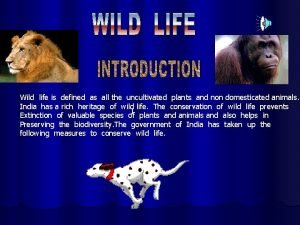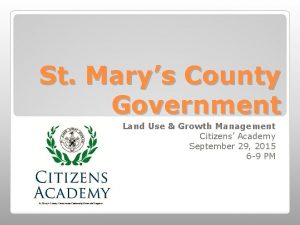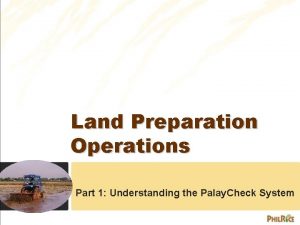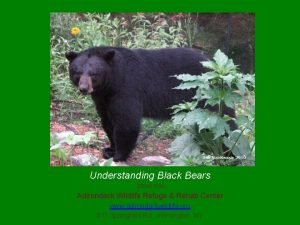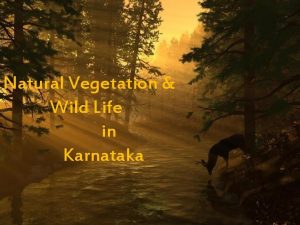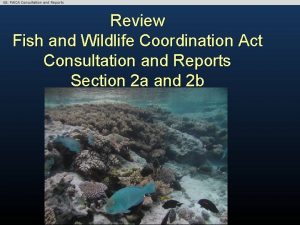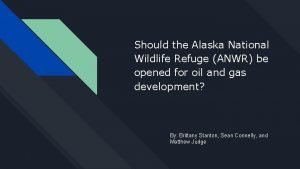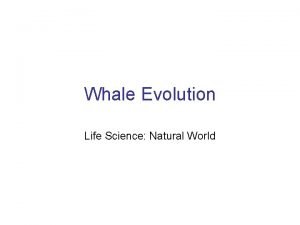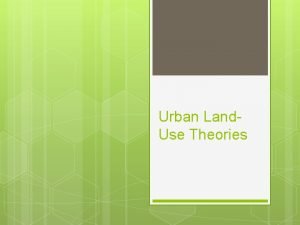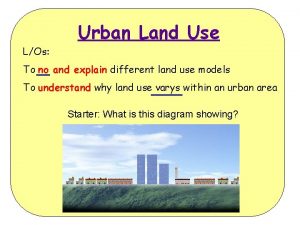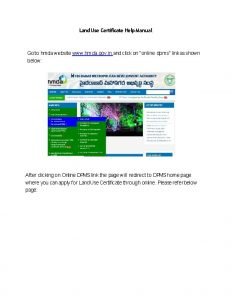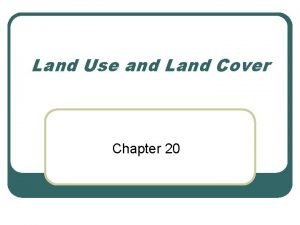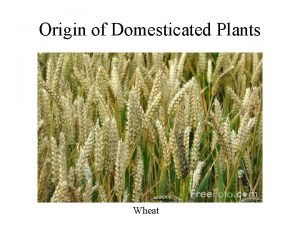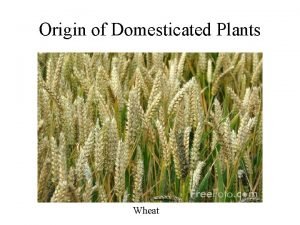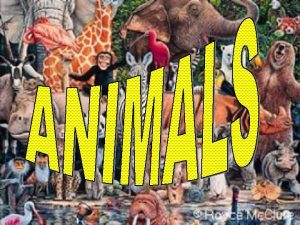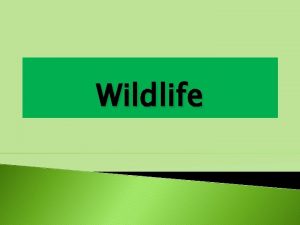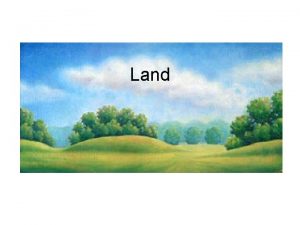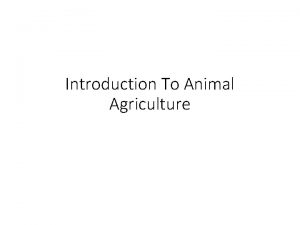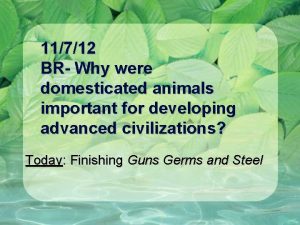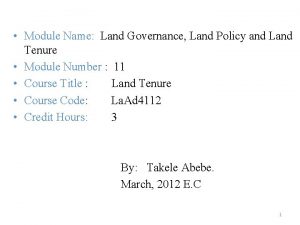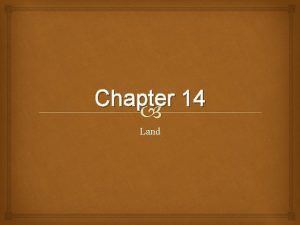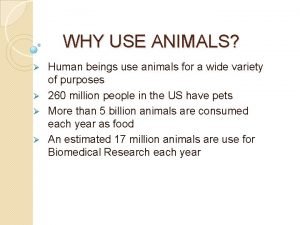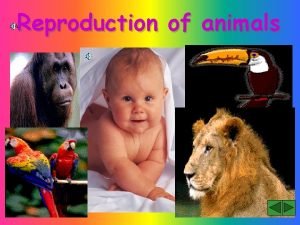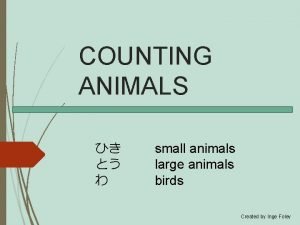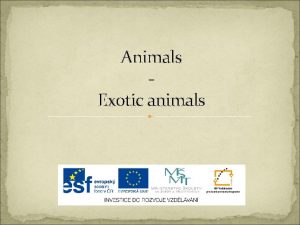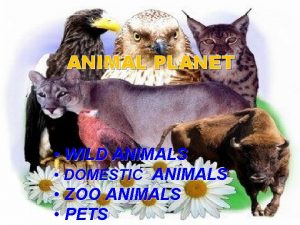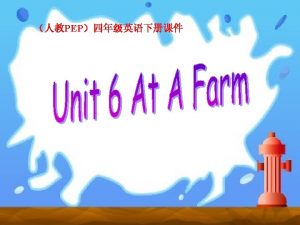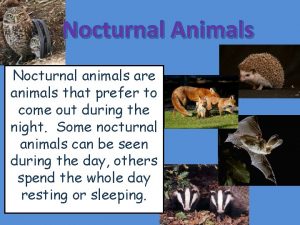Module 4 Wildlife Domesticated Animals and Land Use























- Slides: 23


Module 4: Wildlife, Domesticated Animals, and Land Use

Learning Objectives • Identify potential routes of contamination from wildlife, domesticated animals, and land use • Describe practices to mitigate risks associated with wildlife, domesticated animals, and land use • Describe co-management strategies that address conservation and food safety goals • Describe the importance of conducting a pre-plant and pre-harvest assessment of fields • Describe corrective actions that could be used if significant risks are present in production fields • Identify records that should be kept to document any management, monitoring, or corrective actions

Animals Are A Produce Safety Concern Because They: • Can carry human pathogens – e. g. , E. coli O 157: H 7, Salmonella, Listeria monocytogenes • Can spread human pathogens – By depositing feces in fields – By spreading fecal contamination as they move • Are very difficult to control – Birds and small animals travel unnoticed – If fencing is used, even the best fence can be breached – Complete exclusion is not possible 4

Wildlife on the Farm • Can be a natural and valuable part of the landscape and farm environment • Depending on species, management options may be limited by county, state, or federal law • May be resident or transient (e. g. , migrating species) • Wildlife with close association to human activities may pose greater risks – e. g. , seagulls feeding at dumps, starlings feeding in cattle feedlots 6

Assessing Risks: Wildlife • Do you find wildlife feces in your produce fields? – How often? Is it widely distributed? Is it in contact with produce? • Is your farm in an area that large numbers of animals visit (e. g. , flocks of migrating birds, herds of deer)? • What management practices can limit wildlife contamination of produce fields and water sources? 7

Co-Management: Striking a Balance • Farmers must address food safety requirements, but should keep the conservation of natural resources in mind • Farmers also have stewardship, aesthetic, and business objectives of their own • Co-management considers both food safety and conservation of natural resources 8

Co-Management Considerations • Some conservation practices support wildlife and may increase wildlife activity near produce fields • As food safety concerns have increased, some farms have stopped or changed their conservation practices, particularly those perceived to provide habitat for wildlife (e. g. , vegetation and water sources) • Removal of conservation practices can damage natural resources (e. g. , soil, water, wildlife) and may not mitigate hazards posed by domesticated and wild animals 9

Skills to Support Co-Management • Review the risks and benefits of practices as they relate to food safety and conservation – e. g. , bare ground buffer and hedgerow vegetation • Consider impact on conservation when implementing produce safety practices – Unintended consequences – Direct conflicts between produce safety and conservation 10

Monitoring Wildlife Activity • During the growing season: – – – • Monitor feces and evidence of intrusion Evaluate the risk of fecal contamination on produce (e. g. , tree vs. root crop) Consider past observations and wildlife attractants Immediately prior to harvest – Monitor fecal contamination, signs of animal activity (e. g. , trampling, rooting, feeding, tracks) – Assess risks and decide if the crop or a portion of the crop can be safely harvested 11

Deterring Wildlife Decoys Fencing & Netting 12

Deterring Wildlife Visual Deterrents Noise Deterrents Tactile Repellent Relocation 13

Domesticated Animals on the Farm • Domesticated animals, such as livestock and pets, may harbor human pathogens • Domesticated animals are sometimes used in fields – As working animals – As wildlife management (i. e. , dogs) – To graze crop residues/culls • Assess the risk if animals are allowed or are likely to enter your production fields 15

Assessing Risks: Domesticated Animals • Are domesticated animals allowed in the field while the crop is present as part of the production process? – Are they working animals? • Are workers aware of cross-contamination risks from fecal contamination of hands, clothing, shoes, and equipment after handling animals or fecal material? • Are production fields rotated into grazing land? – If manure is present on the ground, one recommendation is to extend the period of time between when animals were grazed and when produce can be planted 16

Assess Risks BEFORE Planting • Assess the field location – Topography, wind patterns, water movement – Previous uses (e. g. , grazing, landfills, manure applications) – Impact of domesticated animals • Assess adjacent land uses – Animal production, compost, or manure storage – Residential, commercial, or other land uses • Assess wildlife risks – Number, movement, likelihood of fecal contamination 17

Working Animals • The best way to minimize risk is to not allow working animals in the field when the edible portion of the crop is present • If working animals need to be used close to harvest: – Establish paths to minimize contact with growing areas – Have an SOP that outlines practices to take if an animal defecates (poops) in the field near or on produce • Anyone working with the animals should understand risks and be trained to minimize risks • Develop SOPs for animal and manure handling – e. g. , handwashing, cleaning and sanitizing tools, practices to complete after handling animals 18

Pets • Should be excluded from produce fields • Visitors to the farm should be instructed to leave their pets at home • Farms with petting zoos should have handwashing sinks available and signage instructing visitors of the food safety policies 19

Pre-Harvest Assessment A process to assess fields before harvest to help determine if: – Fecal contamination is present, or signs indicate a risk (e. g. , tracks, trampling, rooting, feeding) – Fresh produce has been contaminated and cannot be harvested – Corrective actions, such as no-harvest buffer zones, are necessary – Harvest can safely proceed 20

Corrective Actions: What To Do If There’s Contamination 1. Do not harvest any produce that may be contaminated 2. Determine if no-harvest buffer zones around the contamination are sufficient to reduce risk to allow harvest of the uncontaminated produce • Suggested no-harvest buffer zones vary from a 0 -25 foot radius, depending on the crop, climate, contamination event, and harvest equipment 3. Consider other corrective actions that could reduce contamination risks 21

Corrective Actions Continued 4. Make a decision about what to do with the contamination • • Remove, leave, bury, or use other strategies Consider risks that could result from these actions (e. g. , cross-contamination of equipment with feces) 5. Document all actions • Monitoring, deterrence, and corrective actions 22

Worker Training: Establishing Your Front Lines of Defense Workers must receive training to: • Recognize and not harvest contaminated produce • Inspect and correct problems with harvest containers and equipment or report issues to a supervisor, so they do not become a contamination source Workers must: • Take measures to not harvest contaminated produce • Wash hands after handling animal feces or any time hands may be contaminated Workers should: • Report food safety concerns to a supervisor 23

Recordkeeping Records must be kept for: • Worker training Records should be kept for: • Pre-plant land assessments • Monitoring for animal activity • Actions taken to reduce the risks related to animal intrusion into crop (domesticated animals and wildlife) • Pre-harvest risk assessments • Intrusion and contamination events • All corrective actions taken 24

Summary • Feces and urine from domesticated and wild animals can contaminate produce fields and water sources • Conduct pre-planting and pre-harvest assessments • Presence of animals in the environment does not necessarily mean that produce is contaminated • If animal intrusion occurs, fields must be monitored during the growing season for evidence of contamination • Steps should be taken to reduce risks from animals • Co-management should be used to balance food safety and conservation goals • Document all actions taken to reduce risks from animals and adjacent land uses 26
 Non domesticated animals and uncultivated plant life
Non domesticated animals and uncultivated plant life Asian massage mongol
Asian massage mongol Write a simile comparing a tree with a domesticated animal.
Write a simile comparing a tree with a domesticated animal. Are bears producers or consumers
Are bears producers or consumers Detritus food chain
Detritus food chain Carnivore
Carnivore Https://a-z-animals.com/
Https://a-z-animals.com/ What are landforms
What are landforms An area of land largely enclosed by higher land
An area of land largely enclosed by higher land C device module module 1
C device module module 1 St mary's county land use and growth management
St mary's county land use and growth management Differentiate wetland and dryland preparation
Differentiate wetland and dryland preparation Adk wildlife refuge
Adk wildlife refuge Mixed forest of karnataka
Mixed forest of karnataka Fish and wildlife coordination act
Fish and wildlife coordination act Anwr drilling pros and cons
Anwr drilling pros and cons Why did orwell use animals instead of people
Why did orwell use animals instead of people A mushroom and a humpback whale are alike because both are
A mushroom and a humpback whale are alike because both are Rodhocetus
Rodhocetus Hoyt's sector model
Hoyt's sector model Urban land use
Urban land use Land use planning '' lecture notes
Land use planning '' lecture notes Land use certificate fee
Land use certificate fee Usgs land use classification
Usgs land use classification
